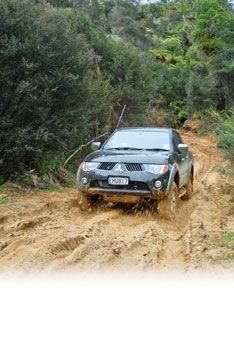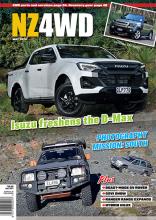Although the Mitsi Triton has been with us for some time now, there’s been a glaring hole in the lineup – and that’s an automatic diesel! Kiwis have for some time now been switching over to automatics as traffic pressures coupled with the advent of more efficient self-changing gearboxes, plus lower add-on costs compared to manuals, have made them more attractive. However that gap has finally been plugged, and our test vehicle was the GLS version, which comes chock-full with features, plus wider tyres on alloy wheels, and among other special features an electrically-operated rear window which allows you to easily access the wellside from the back seat – especially useful when you’ve a canopy on the back, in which case it makes it as useable as a regular station wagon. Driver and front passenger airbags are standard, while special GLS features include climate control air conditioning, six-speaker MP3 CD player and five electric windows including that at the rear. The passenger’s side bag can be manually disengaged (e.g. to protect infants in rear-facing child seats). Other features include leather on the wheel and gear knob, privacy glass, central locking with keyless entry, plus electrically adjusted mirrors. The GLS also gets a map light plus a spectacles holder in the roof. The two-tone interior trim is bright and airy, very modern, while legroom in front is good, and there are nice comfy seats in the back, with plenty of knee room. It has a nice dashboard and instrument panel, the latter with modern blue faces with white lettering, and including a revcounter as well as the speedo and water and temperature gauges. There are well laid-out controls, with a line of simple rotary switches for the air and heat, plus a multi function display (MFD) in the centre of the dash which has a digital readout for outside temperature, clock with date, barometer, compass, altimeter, trip computer with fuel, speed and distance to empty functions. The MFD also shows the information for the audio system, but the stereo volume switch is down below it on the left-hand side, more difficult for the driver to get to. But the Triton gets a “proper” handbrake, located between the front seats where the driver CAN easily get at it. It’s easy to get comfortable at the wheel, with tilt height adjustment of the steering as well as fore-aft seat movement, and there’s reasonable support from the seats. The load area features four strong permanent tie-downs inside the lined wellside, with a rear step to allow easier access into the back, but the scalloped sides limit versatility. The Triton has a double wishbone independent front suspension with coil springs and an antiroll bar, plus a simple leaf sprung live axle rear. On tar seal handling showed a tendency to understeer, but there wasn’t much body roll, though the ride was a bit stiff at the rear without a load on board, legacy, we feel, of its full 1 ton payload – among the highest in its class for a 4WD ute. Steering is by power assisted rack and pinion with a turning circle of 11.8 metres. The lusty 3.2 DI-D four cylinder turbo-charged and intercooled diesel engine delivers 118 kW at 3,800 rpm with 347 Nm of torque at 2,000 rpm to give good acceleration and low-down flexibility, but it became a little harsh and noisy under acceleration, quieting down at cruise speeds. Driving with the back window open gave better airflow if you preferred not to use the aircon, and didn’t result in significantly more noise inside the cabin. Off-road, first thing we noticed – and loved – was the simple twin lever system for the four-wheel drive. This means you always know when low-range has been selected – not always the case with electronic switch selectors. There’s also a 4WD indicator in the dash so you’re double sure. All Tritons are equipped with an Easy Select 4WD system that allows engagement of 4H 4WD on the fly at up to 100 km/h. The auto gearbox was smooth and easy shifting, although it only has four ratios, with first and second locking up if selected manually. Off-road first gear in Low ratio was low enough to make descending steep hills safe and positive. We didn’t have to use the brakes at all – just as well in the slippery conditions. However, having the range-shift lever on the right-hand side resulted in it often rubbing against one’s leg, which was uncomfortable as the lever moves when the vehicle is in motion. The front axle hubs are fitted with an automatic locking device meaning the driver does not have to get out of the cabin, very handy in inclement weather. Most important of all, though, was that rear diff-lock, controlled by a switch on the dashboard which also turns off the ABS braking system. A locked diff differs greatly from a limited slip differential – fitted to every other “one-ton” 4WD ute on the market. A limited slip diff allows for some slippage in its internal clutch packs when transferring torque at times of wheelspin, meaning that eventually you can get one wheel turning and subsequently no power to the other. However a locked diff offers no slippage and when engaged both rear wheels turn at the same speed, greatly improving traction when needed. Once the rain came down we found this feature particularly useful on a couple of the steeper hills, and when exiting a river up a steep bank at which the Nissan had baulked. There were also a couple of times when the Triton was cross-axled as we climbed an embankment, causing a rear wheel to spin as it found air – but punching in the diff. lock sorted this straight away, without having to resort to reversing and powering through. However visibility off-road isn’t a strong point, thanks to the low seat position and curvaceous bonnet. Both on and off-road one of the things we particularly liked about the Triton was the braking system. With five adults on board and a load in the back it’s important not just that it goes, but that it STOPS, too – often a problem with double cab utes. Not only does the Triton have ABS brakes with electronic brakeforce distribution (EBD), but it has HUGE ventilated front disc brakes, 406 mm in diameter, and this showed in our brake testing where the vehicle stopped from 100 km/h in just 22.8 metres. As far as routine maintenance is concerned the Mitsubishi layout is quite good and open, albeit a bit spread out. The air intake is placed higher than the others are, at the front over the radiator, but this position makes adding a snorkel difficult. The alternator is not very accessible, but protected, and serious off-roaders would find it possible to put a second battery under the bonnet, but it would have to be small. Economy is a strong point, and the Triton was consistently more economical than the heavier and larger Nissan. It also proved more nimble in all conditions, and while we had to air down on the Nissan in the slippery conditions, the Triton coped quite well on standard tyre settings. In summary the Triton is a luxurious yet very capable 4WD. Some people might think it’s too pretty to take off-road, but at no time did we have to pussyfoot or worry about plastic bits being pulled off. In fact, despite that, like the Nissan, it has only 205 mm ground clearance, it proved a worthy workhorse, not just a fair weather friend. *
MITSUBISHI - TRITON - 3.2 GLS Double Cab WELLSIDE
Tuesday, 12 August 2008



